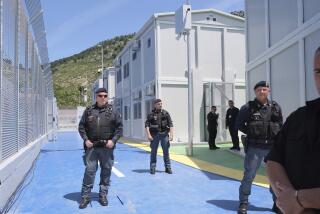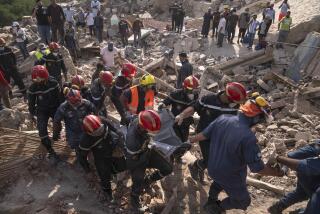Albania Stuck in Poverty--and the Past
TIRANA, Albania — On the road to the capital, farmers carry hoes and herd flocks of goats and sheep. A horse-drawn plow slices the red clay. Carts are dragged by horses, donkeys and oxen.
There are few cars or trucks, and virtually all of them are government-owned. Albanians walk so much, almost no one gets fat.
In smaller cities some of the streets are cobblestone, and at night it’s nearly silent. There are no cars, no planes overhead, no sounds of horns, radios or stereos. Street lamps are about 100 yards apart, the bulbs no stronger than a pocket flashlight, and it’s possible to hear the whoosh of an occasional bicycle.
To come to Albania is to step back into the 19th Century and into the most longstanding poverty on the European Continent. Albania is the last of the rigid Stalinist governments, but whether the leadership will stay in control is anything but certain. In the past two weeks, about 5,000 Albanians have vaulted over the fences at foreign embassies in Tirana, and the government has allowed the first wave of refugees to leave the country under diplomatic escort.
Even if Albanian President Ramiz Alia’s regime survives, he will face the twin worries of mushrooming political dissent and the task of modernizing his creaking Communist economy.
Many Albanians who left said they had wanted to escape not only political repression but also grinding poverty. After 10,000 pro-democracy demonstrators filled Tirana’s streets recently, four government ministers in charge of food, light industry, internal trade and public services were sacked, apparently in hopes of speeding up Alia’s economic reforms.
Albania was the poorest country in Europe when Enver Hoxha and his Communist rebels chased Nazi occupiers out in 1944. Under Hoxha’s dictatorship (he died in 1985), and his protege Alia, the country has been wrenched into better times. No one is starving, but Albania is still Europe’s poorest nation, and there isn’t enough meat, cheese or fruit to go around.
The sweep of other revolutions in Europe has upset Albania’s old bartering system with its East Bloc neighbors. Now those countries are gearing up for free-market trade and want hard currencies, not Albanian leks. “That puts Albania in absolute economic isolation,” said a Western diplomat posted in Tirana. “Albania needs several billion dollars to revitalize their factories. You cannot pay for that in cucumbers and tomatoes.”
To try to build up Albania’s exports to generate hard currency, Alia has even pushed through some capitalist-style worker incentives. But overhauling the lagging economy is a huge task, and the backwardness is visible in the streets. In Tirana, there are only a few stoplights, and the handful of cars and trucks--too few to provide more than essential transport--are all imports, snapshots of Hoxha’s xenophobic policies.
There are Soviet Volgas dating back to Moscow’s economic aid of the 1950s; green Chinese jeeps from the 1960s, when Hoxha turned to China after cutting off the Soviets; and newer Zugs from Poland, Aros from Romania, Skodas from Czechoslovakia and IFAs from East Germany, all imported after Albania’s alliance with the Chinese fell apart.
Distrustful of outsiders, repressive against their own people, Hoxha and Alia made progress, nevertheless, in some important areas. Under their regimes, life expectancy nearly doubled, they virtually wiped out illiteracy, founded the first university, and built the first railroad and the first television stations. They constructed factories, excavated medieval castles, built museums.
The Communists set up hydroelectric stations, and even during a recent drought, 75% of their electricity came from river water. Marshes were drained, arable land has nearly doubled, and hillsides and mountains are carved with rows of trees and plants. Farmers grow tomatoes, corn, olives, cherries, sugar beets, tobacco, hops.
It’s still not enough. Albania’s population has tripled since World War II, and the nature of the land itself makes farming difficult; three-quarters of the country is hills and mountains. Getting produce to market is hard on the narrow, winding, unlit roads. The drive from Tirana to Korce in the east--75 miles as the birds fly--takes four hours.
“Fifty years ago we came out of the darkness,” said Bashkim Pitarka, Albania’s ambassador to the United Nations. “We had illiteracy, hunger, disease. We began almost from scratch. You cannot compare us to your country.”
A married couple and their two school-age children live in a four-story apartment house in Tirana. The grounds have no grass or trees--only rocks, broken concrete, dirt and weeds. There is no light in the stairwell. The sharp smell of kerosene for cooking fills the hallways.
The building is identical to many others except for the number painted next to a white letter P . The P is for pallati , or palace. An American would call this palace low-income housing.
The family lives in three rooms plus a kitchenette and a toilet. The main sitting room doubles as a bedroom. In the kitchenette, they have a kerosene stove no bigger than what an American would take camping. They have a larger wood-fired stove that also serves as a heater in the winter.
At night the apartment is dim. Light comes from 40-watt bulbs.
By Albanian standards the family is well-to-do: They own a three-foot-tall refrigerator, a washing machine (no dryer) and a black-and-white Albanian television set. There is no telephone.
Their bathroom has a sink and one hole in the floor. Old newspapers serve as toilet paper. A plastic container holds extra water for a hand shower. (At least in Tirana the water keeps running; in some smaller cities it flows only four hours a day.)
Their balcony serves as both closet and garden. Wood left over from the winter is stacked in a corner, and grape plants snake up a wire. The family will crush the grapes to make raki , a kind of Albania vodka.
Television is the chief source of outside information. Apartment rooftops in Albania look like they are decorated with scarecrows, but the jagged figures are homemade TV antennas that pull in signals from Italian and Yugoslav stations.
This family drilled a hole in their apartment wall, then ran a copper wire 30 feet to a pair of antennas on the roof. While an American was visiting, their teen-age son moved a sheet of aluminum foil in front of the TV set for fine tuning, and a Yugoslav soap opera came on. “I prefer ‘Dynasty,’ ” his older brother said. “I understand Joan Collins is very rich.”
For the visitor, this couple prepared an elaborate meal.
Later, a dissident explained that when a foreigner visits, Albanians go to a police station for a document entitling them to buy extra meat, cheese and coffee. “We must not be seen by you without food,” he said.
In this family, both parents work, as do most in Albania. Their combined salary is 1,800 leks a month, or about $260. Prices in Albania have not budged since the 1960s, so their apartment, with utilities, costs $14 a month. But 75% of their pay goes for food.
They hope their appliances do not break down because there is no credit in Albania, and the 200 leks they save each month is for a color TV.
The couple asked their visitor how much he made. The American wrote down his annual salary. It was a half-century’s income for one Albanian. That’s before taxes, the American said.
“What are taxes?” one asked.
To try to wake up the economy, the Albanian government has approved a series of steps in recent months: Now workers elect their factory bosses. If production goals are met, workers get three months’ extra pay. Inefficient businesses are closed down. Each farm family has been given a plot of land and 10 sheep, or one cow and five sheep, to prod them to work harder by allowing them to sell their extra food.
Getting people to work harder is also a problem in factories. Recently, three Turkish cement experts toured an Albanian factory to offer advice on building new cement-making machinery. A visitor named Nahib was stunned to see Albanians use an ancient water slurry system to refine crushed rock, instead of a more efficient dry production method. He also saw plenty of workers sitting around. “First,” he said, “they must find a way to get people to work more.”
At the Enver Hoxha Automobile and Tractor Factory in Tirana, the foundry looks like a scene from the early Industrial Revolution. It is badly lit and dirty; the brick floor is broken up, and shards of metal lie on the ground.
Some of the lathes were made in the Soviet Union 30 years ago, but most of the rows of dirty green machines are engraved with Chinese characters. The machines were reliable “when they arrived,” said chief engineer Fatos Miraci. “After 20 years, it is time to replace them.”
There are no robots here. “I’ve read about robots,” Miraci said.
Last year, production at the factory was valued at 200 million leks, but only 3% was exported, generating $800,000 in hard currency. Miraci wants to double exports because under the new economic policy he can invest some of the hard currency.
“We have a modernization plan,” Miraci said. He has three computers, including an IBM, but he dreams of 15 more to computerize the factory’s finances, engineering and production control.
He needs the help. There are 110 types of motors used on cars, trucks and tractors in Albania, including engines with two, three, four, five, six and eight cylinders, he said, and his factory makes parts for all of them.
“The state wants us to build parts because it’s very expensive to buy them. We have to pay for them in dollars,” Miraci said.
Overhauling machinery is one problem; getting people to work harder is another. The tractor factory has 4,000 workers, but almost no one appears in danger of breaking into a sweat. Clusters of Miraci’s workers stand around in small groups, killing time.
Hekuran Mara, senior economist at the Albanian Academy of Sciences, said: “I am not telling you a secret that our technology is all from before World War II. We need a lot of money, especially hard currency. We must buy and import this technology.”
He put the cost of overhaul at more than $2 billion, but Albania’s exports produced only $400 million in hard currency last year, and only 15% is invested in factories.
Still, Mara said, the government’s new economic incentives will boost total production 5% to 7% a year.
What about individual productivity? All those workers just standing around?
“This is true,” Mara conceded. “But we cannot make all these changes immediately. We have no illusions. We are realistic.”
More to Read
Sign up for Essential California
The most important California stories and recommendations in your inbox every morning.
You may occasionally receive promotional content from the Los Angeles Times.











